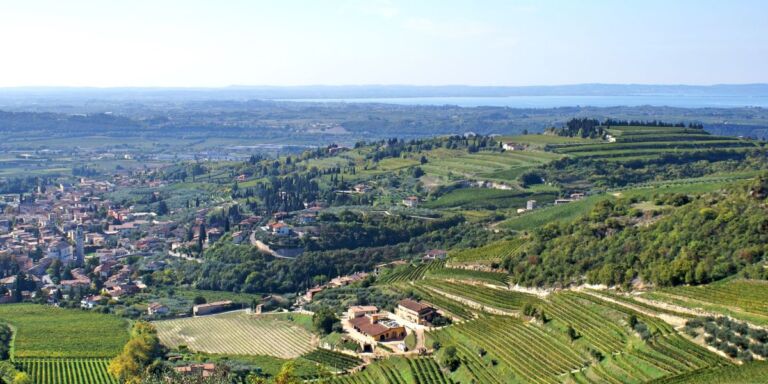Considering the grandeur of some of the world’s starriest winemaking estates, you could be forgiven for expecting something a little more imposing when visiting Rhône stalwart Domaine JL Chave. Here, in a little corner of the celebrated yet understated appellation of Hermitage, there are no iron gates or manicured gardens. Not even a turret. You simply stroll along the main road in the village of Mauves, passing unpainted terraced houses until you reach a rusted, bent, illegible sign.
Walking through the sliding wooden doors underneath, you enter a courtyard dominated by a giant horse chestnut tree. On the day of my visit, the air is sweet with childrens’ laughter as they race each other on a sack truck, and the fruity scent of grape juice surrounds the press. It’s a disarmingly humble scene, which belies the fact that this ancient family-owned estate is on the verge of an exciting new chapter. And for owner Jean-Louis Chave, as he nears the completion of what he sees as his legacy, the project holds a deep personal significance.


With the estate’s famous native appellation fully planted, Chave has spent the past two decades focusing his energies on revealing the potential of certain exceptional sites in the less fashionable, somewhat workhorse neighbouring AOC of St-Joseph. The family owns several favoured sites in this long, thin appellation that runs along the west bank of the Rhône, from Cornas in the south to Côte- Rôtie in the north. Unlike Hermitage, St-Joseph covers a massive stretch of land that includes some inferior terroirs. But there are several unofficial ‘premier cru’ sites, particularly where tributaries to the Rhône have created south- and southeast-facing slopes and where, as the climate warms, the quality potential rises. Among them, Chave would include Les Chalaix, Les Oliviers, La Dardouille, lieu-dit St-Joseph, Ste-Epine and Bachasson.
Before now, Chave has blended the wine from these sites together to create a single domaine St-Joseph. The 2015 vintage marks the inaugural bottling of a single-vineyard cuvée, Clos Florentin, a beautiful, peaceful walled vineyard and garden on the outskirts of Mauves that he bought in 2009 and which had long been cultivated organically by its previous owners. The wine is made in the same way as his blended St-Joseph: destemmed, with no new oak. The result is exceptionally refined, with great purity and depth, and it marks a new pinnacle of quality for the appellation.
When the time is right, Chave plans on bottling more single-vineyard St-Josephs. Most meaningful for him will be that of Bachasson, the original family plot where Chave’s ancestors first started tending vines more than 500 years ago. In the late 19th century it was ravaged by phylloxera and abandoned, before, over 100 years later, in 1996 Chave began the arduous task of rebuilding it, along with other forgotten plots.
In tragedy, there is hope
‘Bachasson is the origin of the family,’ says Chave, as he unfurls several large-format photographs of the now revived vineyard. It’s a steep granite hillside that needed not only clearing and replanting but an extensive programme of dry-stone wall building to fortify the terraced vineyards. ‘That was the first major work that I undertook,’ he says.
It is sobering to think that Chave is going back to his family roots, since those roots run very deep indeed. His ancestors first started growing grapes in 1481, when a local nobleman presented them with the farm and vineyard at Bachasson. It sustained them for centuries, but in the 1870s, like much of France, the Rhône vineyards were decimated by the phylloxera louse. Bachasson wasn’t spared.
‘In 15 years, they lost it all,’ says Jean-Louis. ‘It was a brutal change. It was seen as a curse… The hillside was abandoned, the family moved down to Mauves, to the valley – a very poor farm where they had some goats, some cereals… It was a tragedy. But in tragedy, there is hope.’

Eventually, his predecessors turned to winemaking once again but this time concentrated on the best terroirs – and in this part of the Rhône, that meant Hermitage. Located 2.5 miles from Mauves on the opposite side of the river, the hill of Hermitage rises up sharply, facing due south. It is hard to imagine a more perfect hillside for growing grapes. The wealth of different soil types there give each lieu-dit its own personality and combine to create majestic, complex reds and whites that can last for decades.
‘Up until phylloxera, the grand cru [of Hermitage] was totally reserved for the elite – the church or the nobility,’ says Chave. But phylloxera, combined with changes brought about by the Industrial Revolution, offered a unique opportunity for his family to acquire vineyards. ‘There were many grand families who lost their vines to phylloxera, and they reinvested their money in nascent industries such as textiles, silk, paper, leather. They left Hermitage – and that was how my family were able to buy land.’
Taken as a whole, phylloxera was a blessing rather than a curse, says Chave. ‘Without it, we would have stayed Ardèche vignerons in St-Joseph. We might have had vines, or perhaps goats for cheese. Phylloxera cost us the vineyard at Bachasson that we’d cultivated for 400 years. But it opened the door to Hermitage.’
It was Jean-Louis’s great-grandfather who first acquired a holding on Hermitage, but it wasn’t until the 1980s that the estate really gained a foothold. In 1983, Jean-Louis’s father Gérard was given the opportunity to purchase the Domaine de l’Hermite, a 4ha estate spread across some of the finest lieux-dits on the hill. ‘It was an enormous turning point for the domaine,’ says Chave.
As the wines have become increasingly collectible, land on the 137ha hill of Hermitage has become highly sought after. It has gradually been consolidated into fewer and fewer hands and is now mostly owned by large négociant houses and the local cooperative winery. ‘My generation was never able to buy on Hermitage like that,’ says Chave. ‘And we’ll never be able to again. It’s for that reason that my generation is going back to St-Joseph.’
The hope is that, with Chave now showing the way to new heights of quality in St-Joseph, this may signal a renaissance for the appellation. But there are huge challenges to overcome. ‘The vines need to age a little more,’ Jean-Louis says. ‘And the soils need to be worked just as well as in Hermitage; the viticulture needs to be just as good. And that’s the challenge. It’s very expensive to cultivate, but the price of a typical St-Joseph isn’t the same as a Côte-Rôtie, a Hermitage or even a Cornas, so people need to invest more to be able to charge more. But that will come. The ultimate aim with a family domaine is to pass it on,’ he adds, ‘so I’m a custodian.’
Jean-Louis Chave may be the owner of one of France’s greatest estates, but he remains remarkably down to earth. And in promoting the estate from a leader in one appellation to a leader in two, the 17th generation will have a lot to thank him for.

Sunshine and igloos
Jean-Louis Chave may have been born into wine, but it was not his first interest. ‘My passion as a child, which might seem a bit odd, was finance. My grandmother looked after the family finances, and she loved the stock market. I remember, as a child, when I came home from school, we weren’t allowed to talk, because financial news was on the radio, and she would be listening and taking notes.’ The experience inspired the young Chave, who, at 14 years old, started dabbling in shares himself. ‘I didn’t create a wine tasting club,’ he says. ‘I created an investment club.’
Chave went on to do an MBA in finance and found himself at the University of Connecticut through an exchange programme. At the time, France still imposed military service; to delay joining up, he enrolled at the University
of California at Davis, where he studied sensory analysis and, eventually, winemaking. Unable to put off military service any longer, he returned home in 1992 to do a year with the chasseurs alpins – the elite mountain regiment of the French army – where he could indulge his love of the outdoors.
‘It was tough. We spent time in igloos, we dug holes in the snow, spent weeks in the cold. I’d done my studies in California, so to move to that was particularly hard.’ Keen to feel the sun on his back again, he helped out with the 1992 vintage, before joining the family domaine definitively in 1993.




